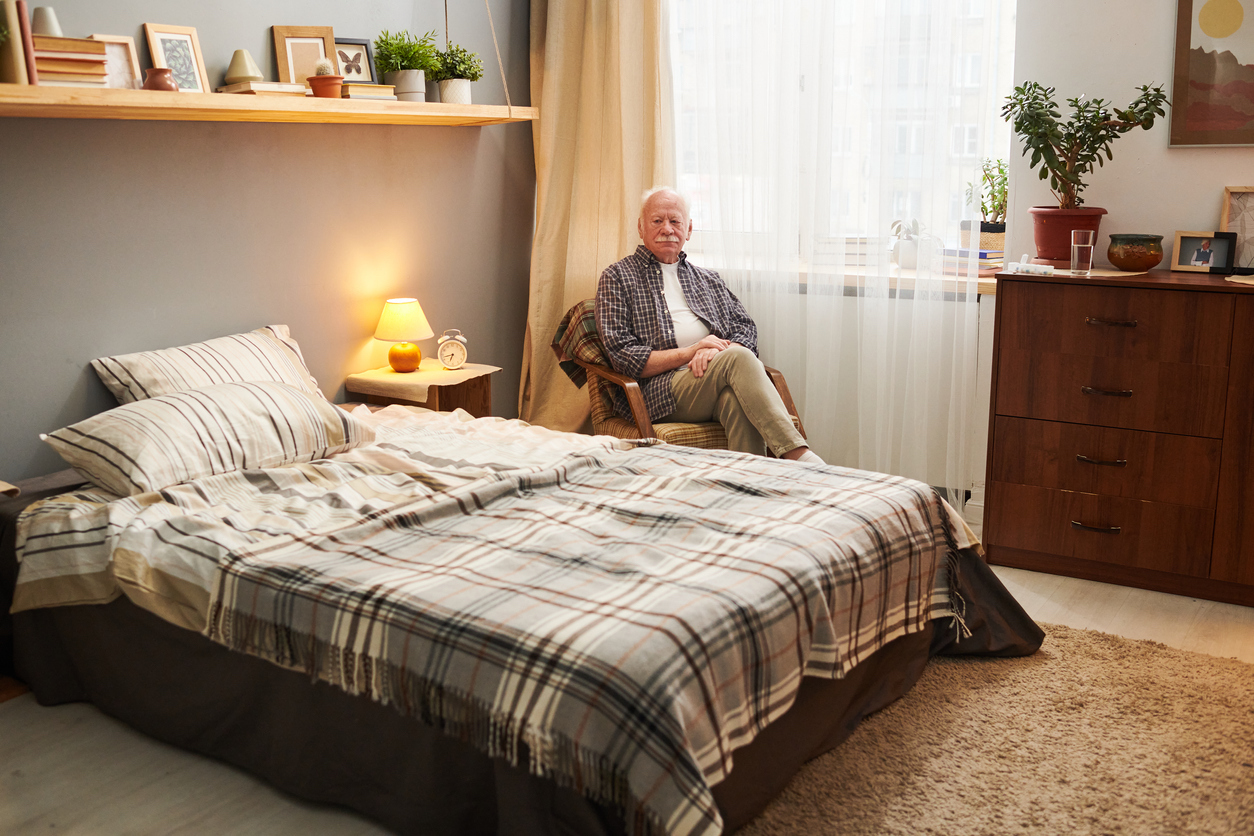 https://jacksontr.com/wp-content/uploads/2022/06/Depresssion.jpg
837
1254
Matt Jackson
https://jacksontr.com/wp-content/uploads/2023/02/JACKSER001logo_Since2003.png
Matt Jackson2022-06-10 10:20:082022-06-15 11:16:46Therapeutic Recreation Programming for People Displaying Symptoms of Depression
https://jacksontr.com/wp-content/uploads/2022/06/Depresssion.jpg
837
1254
Matt Jackson
https://jacksontr.com/wp-content/uploads/2023/02/JACKSER001logo_Since2003.png
Matt Jackson2022-06-10 10:20:082022-06-15 11:16:46Therapeutic Recreation Programming for People Displaying Symptoms of DepressionDecorate a room in a retirement or nursing home to be personal, comfortable, and functional.
One of the many daunting tasks a caregiver can have is how to plan and decorate a retirement or nursing home room so it is a personal, comfortable, and functional living space for your loved one. You want a safe place for your senior to live but you also want this space to feel like home, to have personal meaning, and not just be four walls and a bed. You need to achieve all of this with limited space and within the guidelines from the care home. It is an undertaking that can feel overwhelming at a time when you are juggling many items on your to-do list and difficult emotions.
This article offers help for planning or improving the living space of someone living in a retirement or long term care home. The most important factor is to use these suggestions as guidelines while keeping in mind who is living in this space. The space should reflect their life and interests. Elements of personal meaning can support both the person and encourage visitors and staff to engage with the occupant of the room.
Rules and Guidelines for retirement and nursing home rooms
Before adding to the room, talk to the facility to find out the guidelines. Many places encourage making a room feel personal but may have specific regulations especially if the room is shared. Be sure to inquire about your plans before getting started.
Environment
Considerations include:
- Is the room private or shared?
- How much space is there?
- Is there a window with a ledge?
- How much wall space is there for personal photographs or decorations?
Furthermore, the number of drawers and closet space will impact your planning so be sure to note these also. In addition to the storage you will want to consider the flow of the room with space for mobility aids when navigating through the living area.
Materials
Your material list will depend on the recommendations that will work for your loved one and the space. Keep in mind the following items that support most spaces:
- Storage baskets
- Wall hanging solutions
- Labeling supplies
These are all good to have available. For labels consider card stock of a noticeable color and font large enough to read. If you can laminate the labels that is great but if not consider using clear wide tape over the labels to protect them.
Tip from the Pros: Photograph the Room
Practically speaking, a lot of the work to decorate a retirement or nursing home room to make it personal and functional occurs when you are not not actually there. Remember to take pictures of the entire room, facing each wall. Also consider photographing the inside of the closet and the drawers and their configurations. Knowing the layout of the room, where the doors are, open wall space, windows, electrical outlets, and the storage can help when planning what items to pack. Side note: most facilities do NOT allow painting the walls but there are wonderful stick on / peel off wall décor options that can transform a room in a few easy steps.
A more functional retirement or nursing home room with labelled drawers and baskets
Labels are a great way to organize a room and make it more functional, helping the occupant of the room, visitors, and staff locate items. You can do this by labeling shelves and drawers and baskets, making life simpler for everyone. Labels can be created by hand or typed out. Most important is that the person living in the room can read the labels. If the person’s first language isn’t English, consider making labels with both languages. You may want to test out a few styles, fonts, and color of paper to see what is best for your senior to read and use.
One drawer you are for sure going to want to have clearly labelled is the one with the extra supplies and leisure activities. This helps your elder, visitors, or staff find the resources you have spent time and money to add to the room. Signage will not only help your loved one maintain their independence, it will also direct others to these great supplies, encouraging visitors to engage with your loved one in a more meaningful way and for longer at a time. A crossword puzzle or coloring book will make time spent together more impactful for everyone.
Dementia considerations
Keep in mind, if the person reading the sign has Dementia, you may want to add symbols along with simple text at least 14 font size. Ideally you want the text to be high contrast to the background and use a Dementia-friendly font such as Arial, Times New Roman, or Calibri. A yellow background with black text accompanied with a simple picture is a common Dementia-friendly sign.
Less is More when decorating a retirement or nursing home room
You want to decorate a retirement or nursing home room to make it personal AND functional. Keeping the space clutter free while having essential items available is a balancing act that may take some trial and error. Keeping the space organized makes a more inviting place and allows for better access if mobility is a concern. Use baskets with labels for everyday essentials. Keep a few recreation supplies such as books, magazines, word search or coloring books out and tuck the rest into a labeled drawer. You can rotate through the supplies when needed, this will limit the clutter and keep supplies fresh and interesting. By labeling the supplies other visitors can use the materials when visiting thus creating more meaningful time with your loved one.
Make the room personal by keeping loved ones close
Having pictures of family and friends help your senior reminisce and feel connected. Don’t be afraid to add pictures to the room. Be sure to include recent and older photographs. Some of the most vivid memories will be from childhood and early adulthood. As long as these memories are positive they can help create feelings of security and nostalgia. Equally important to the photographs you select is the labeling of the pictures. Include the names of the people in the photograph and where it was taken if possible. This will avoid any embarrassment for your loved one if they struggle to remember the faces. Plus, visitors and staff can easily see who is in the picture also.
There are 3 basic approaches you can take:
Framed photos
Pros: great for the most important people in the person’s life, can be passed between people, if placed properly they can be seen at all times, easy to label
Cons: uses valuable space for only 1 photo, can be dropped and damaged, may be difficult to hold for people with arthritis or other difficulties with their hands.
Digital picture frames
Pros: can hold literally thousands of pictures, can automatically change pictures making a constant slide show
Cons: can’t label each picture, too many pictures may become overwhelming or confusing and cause frustration or embarrassment if there are memory challenges.
Photo Album
Pros: a more familiar format for most seniors, easy to go through sitting with another person, easy to label pictures
Cons: pictures can be removed or lost, album shouldn’t be heavy, bulky or difficult for the person to handle independently and they need to turn the pages easily
A retirement or nursing home room can be even more personal with a space to decorate for special occasions
This might include a shelf and a wall hook or even a corkboard. Each month change the decorations to coincide with the season, special occasion, or just for fun. It can be a place for family keepsakes or items of personal meaning if you have a special way of celebrating holidays or birthdays. As a result, this keeps the room fun and fresh, and helps your senior feel excited and included in special events.
Having a specific place dedicated to special events and regular changes brings a sense of vitality in the room while saving you feeling the need to regularly redecorate on a larger scale. Giving your senior the chance to make choices and be involved with selecting the changes each time should help them add their own personal meaning plus feel included and more at home. Have a space like this in mind when packing the items to take to the new room.
Music moves the soul
When planning the set up for the room consider a way for your senior to play music. There are many options: radio with CD player, voice command music such as Alexa or Google, music on the television, individual players with earphone, the list goes on. Please remember to select a method that the person is comfortable using. If placing a sticker on the play button for a radio is the most familiar way for the person, don’t buy them a voice activated system that they are intimidated by and won’t use or will cause extra stress. The technology must be user-friend for the specific person or it won’t be used.
Equally important is placement of the music source. You want to make it accessible to the person using it. Don’t tuck it behind books or too low on a ledge. If turning on music is difficult, stressful or risks an avalanche of things falling, the music will not be turned on.
Introduce your loved one to everyone
To be clear this does not mean personally taking them around to meet every staff member. That may not be possible and could likely be over-whelming to most. Instead consider these ideas:
Life Story book
Consider creating a life story book before moving day to accompany your senior. This will tell staff about your loved one: are they an introvert or an extrovert, do they like activities in groups or 1:1, the music they like, favorite television shows, favorite foods, family history, etc. This information will help staff make your senior feel more at home quickly. Further it will give them ideas for how to add personal meaning to activities and interactions.
Family & Friends reference board
Another great option is to create a reference board of family and friends to place in the room, In addition to pictures of loved ones with their names be sure to include how they are related or connected to your senior along with a brief description. In the event your elder forgets someone’s name or staff aren’t sure who they are referring to, the board will provide a quick reference. This will help prevent a lapse of memory from causing needless embarrassment. Remember to use clear pictures of people and write their names large enough to read.
Conclusion
Your mission to decorate a retirement or nursing home room to make it personal, comfortable and functional is attainable. It’s all about the person living in the room. Remember their likes and dislikes while maintaining accessibility and organization. Add their favorite music and pictures, share an amusing story on the reference board, or make a collage of funny photographs. Despite the emotional roller coaster you are on, turn on that music you just set up and have a little fun while you decorate the room.
References & Resources
The Ridge Senior Living. 10 Senior Apartment Decorating Ideas. Retrieved from www.theridgeseniorliving.com/blog/10-decorating-ideas-to-make-your-senior-apartment-a-home/
Southeast Healthline. Preparing for the Move Into Long-Term Care; “A Checklist”. Retrieved from www.southeasthealthline.ca/healthlibrary_docs/LTC – Preparing for the Move.pdf
Legacy Project. Fill-In-The-Blanks Life Story. Retrieved from www.legacyproject.org/activities/lifestory.html
Alzheimer’s Society United Kingdom. Dementia-Friendly Signage. Retrieved from shop.alzheimers.org.uk/helpful-products/dementia-friendly-signage
Alzheimer’s Society of Canada. Tips for Dementia-Friendly Written Material. Retrieved from
www.alzheimer.ca/sites/default/files/documents/DFC-Writtten Comm Tip sheet_Final.pdf
Bright Focus Foundation. Making Your Home Dementia Friendly (2021). Retrieved from www.brightfocus.org/alzheimers/article/making-your-home-dementia-friendly
By Vicki Halliday, Recreation Therapist, Intake Manager, Jackson Therapeutic Recreation Inc.



